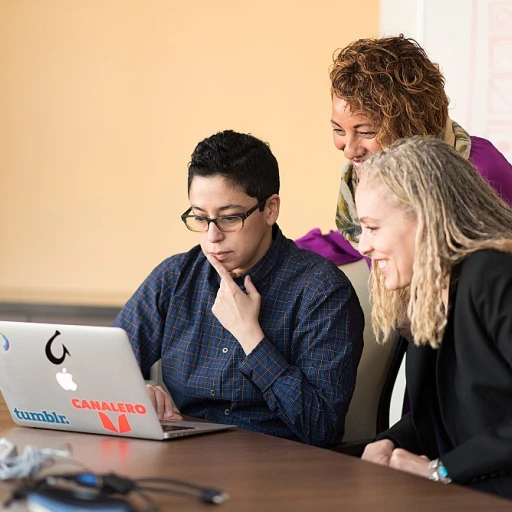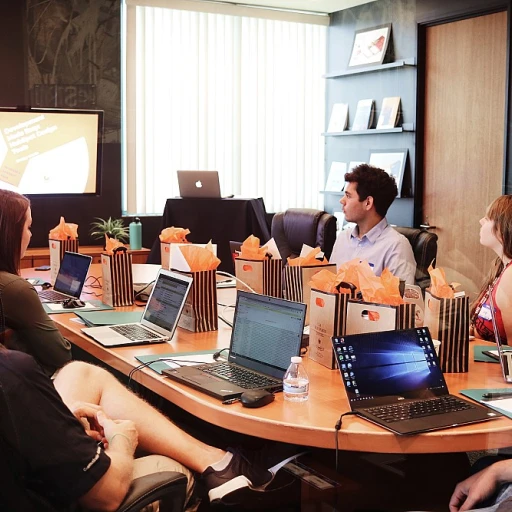
Understanding DEI in the Tech Industry
Diversity, Equity, and Inclusion: Building a Foundation in Tech
In an ever-evolving tech industry, diversity, equity, and inclusion (DEI) are pivotal concepts that drive innovation and company growth. Implementing DEI initiatives in the hiring process is not just about filling quotas; it's about fostering a vibrant, inclusive workplace where diverse talent can thrive. Diversity refers to the presence of differences within a given setting. In the tech field, this can mean a variety of cultures, genders, ethnicities, backgrounds, skills, and perspectives among candidates and employees. Equity ensures fair treatment, access, and opportunities, taking action to identify and eliminate barriers that have led to inequities. Inclusion actively welcomes diverse individuals, creating an environment where unique perspectives are valued. For tech companies, the integration of DEI in recruitment is no longer optional. It's a strategic imperative that impacts overall business success, including innovation, employee satisfaction, and retention. An inclusive workplace that embraces diverse teams often leads to improved company culture and stronger relationships. The focus on DEI has intensified in recent years due to increased awareness of systemic inequalities and the push for more representative work environments. However, challenges abound in crafting an inclusive candidate experience that genuinely reflects diversity equity and supports diverse candidates throughout the hiring process. Exploring various strategies to tackle unconscious bias, companies need to reassess traditional hiring practices and emphasize skill-based hiring. As candidates increasingly evaluate potential employers based on DEI standards, companies must reinforce their DEI efforts to attract top talent and diverse candidates. Ultimately, the journey toward a diverse and inclusive tech environment begins with a commitment to understanding and valuing DEI principles. By nurturing diverse talent acquisition and enhancing the candidate experience, companies are well-positioned to cultivate an inclusive culture that benefits everyone involved. More insights into enhancing fairness with workplace equity technology can be explored here.Challenges in Creating an Inclusive Candidate Experience
Barriers to an Inclusive Hiring Journey
Creating an inclusive candidate experience is a goal for many in the tech industry, yet challenges often arise. These obstacles hinder the effectiveness of DEI efforts, making diversity, equity, and inclusion into complex issues that require targeted approaches. Firstly, unconscious bias is a recurrent issue many companies face in their hiring practices. Despite best intentions, biases influence decisions throughout the hiring process, from job postings to final selections. For example, job descriptions may unconsciously invoke certain stereotypes, discouraging diverse talent from applying. Similarly, bias might influence the evaluation of candidates, with recruiters valuing traits and experiences tied to a specific demographic group. The recruitment process itself can also lack inclusivity. Traditional practices, such as overly rigid qualification requirements or vague interview questions, fail to create space for diverse individuals to showcase their skills effectively. Without a skills-based assessment approach, tech roles remain elusive to many. Moreover, there is the challenge of integrating DEI initiatives within the established company culture. Companies may struggle to genuinely support inclusive workplace values, especially if they haven’t yet addressed the systemic barriers that limit diversity inclusion. As detailed in insights on navigating the role of a pay equity consultant in hiring tech, there is much complexity tied to understanding and applying DEI principles ("link"), which must align comprehensively with hiring processes. Finally, addressing these DEI hiring challenges is not a one-time endeavor. Continual evaluation and adaptation are needed to suit the evolving landscape of diverse teams and candidate expectations. Only through consistent dedication can companies achieve a truly inclusive recruitment experience that benefits everyone involved.Strategies for Improving DEI in Recruitment
Transforming Hiring Processes with Inclusive Strategies
In order to boost diversity, equity, and inclusion (DEI) in recruitment, companies need to adopt strategies that not only attract diverse talent but also foster an inclusive workplace. Having a diverse team benefits company culture extensively, promoting varied perspectives that lead to innovation and growth. Below are key tactics to enhance DEI hiring practices.
- Audit Current Practices: Conduct a thorough review of your existing hiring process to identify and eliminate unconscious bias. Assess how job postings, interview processes, and selection criteria might inadvertently exclude diverse candidates.
- Skills-Based Hiring: Implement skills-based assessments in place of traditional credentials-heavy approaches. This assists in focusing on the competencies candidates bring to the job, ensuring a fair assessment rooted in capability rather than background. Read more about effective evaluations in hiring.
- Structured Interviews: Use standardized interview questions for all candidates to ensure that unconscious bias doesn’t skew the assessment of an applicant’s fit for the role. This helps maintain focus on the candidate’s potential contributions to the company.
- Promote DEI externally: Showcase your DEI initiatives and inclusive company culture via social media and company platforms. By communicating your commitment to diversity inclusion, you not only attract top talent but also set expectations for an inclusive candidate experience.
- Employee Involvement: Engage current employees in the recruitment process as advocates for diverse teams. Encouraging employees to highlight their experiences can provide an authentic insight into the inclusive environment your company offers.
- Continuous DEI Training: Equip your hiring teams with ongoing training programs on the importance of diversity equity and inclusion, allowing them to better champion DEI efforts and implement best practices during the recruitment process.
By integrating these strategies, companies can facilitate a more inclusive candidate experience, ultimately fostering an inclusive workplace where diverse talent can thrive.
The Role of Technology in Supporting DEI Efforts
Leveraging Technology to Advance DEI Initiatives
In the journey to foster diversity, equity, and inclusion (DEI) within the tech hiring process, technology plays a pivotal role. By incorporating advanced tools and platforms, companies can streamline hiring practices to ensure a more inclusive candidate experience. Using these technologies, hiring teams can effectively address unconscious bias, which often hinders the recruitment of diverse talent. For instance, AI-driven tools can be utilized to anonymize resumes and eliminate identifying details that may unwittingly influence hiring decisions. This skills-based approach helps focus solely on the candidate's qualifications and experience, fostering equitable opportunities for all candidates. Social media platforms also offer innovative ways to seek diverse candidates by reaching broader audiences. Through targeted ads and job postings, companies can tap into diverse talent pools that may have been overlooked without the technology-enabled reach. Furthermore, technology aids in enhancing the interview process. Virtual interviews and AI-powered video analytics can offer insights into the candidate's non-verbal cues while maintaining consistency in questioning. This uniformity ensures all candidates are assessed under the same criteria, promoting fairness and inclusion. Technology is not only instrumental in the hiring stage but also in integration into an inclusive workplace. Employee engagement platforms can be leveraged to gather feedback on the recruitment process, allowing companies to identify gaps and continuously improve their DEI efforts. Adopting technology within talent acquisition strategies can significantly enhance the candidate experience. As companies embrace these tools, they move closer to building diverse teams that reflect the diversity of skills and perspectives necessary for innovation and success in today's dynamic tech industry.Measuring Success: Metrics for DEI in Hiring
Assessing the Impact of DEI Initiatives
Measuring success in diversity, equity, and inclusion (DEI) within the hiring process is critical for continuous improvement and demonstrating the value of DEI efforts to stakeholders. To effectively gauge the impact of DEI initiatives, companies need to implement robust metrics that offer insights into various aspects of the recruitment process and workplace culture.
Key Metrics for Evaluating DEI in Hiring
- Diverse Candidate Pool: Track the diversity of applicants across various demographics to ensure a wide range of talent is entering the hiring pipeline. This helps in understanding whether recruitment strategies are effectively reaching diverse talent pools.
- Inclusive Interview Process: Monitor representation on interview panels and assess whether questions and interactions are fostering an inclusive environment. This can reduce unconscious bias and improve the candidate experience.
- Retention Rates of Diverse Hires: Evaluate the retention rates of diverse hires compared to other employees. Persistent gaps might indicate underlying issues within the company culture that need to be addressed.
- Employee Feedback and Surveys: Regularly gather insights from employees regarding the inclusiveness of the workplace and the effectiveness of DEI initiatives. Honest feedback can guide improvements in company culture and hiring practices.
- Progress Toward Diversity Goals: Set clear, achievable goals for increasing diversity within the company and track progress towards these targets. This strategic approach helps maintain focus and accountability.
Leveraging Technology for Effective Measurement
As discussed earlier, technology plays a pivotal role in supporting DEI efforts. Utilizing recruitment and HR platforms with built-in analytics can provide real-time data to refine DEI strategies continually. These tools enable companies to identify where disparities exist, allowing for timely interventions.
Identifying key areas for measurement, such as the ones outlined above, ensures that DEI initiatives are both impactful and aligned with long-term business goals. An inclusive workplace not only enriches company culture but also attracts top talent, reinforcing the importance of continuous evaluation and improvement in DEI hiring practices.
Case Studies: Successful DEI Implementation in Tech Hiring
Real-World Examples of Successful DEI Implementation
In recent years, several technology companies have made significant strides in refining their hiring practices to foster a more diverse and inclusive workplace. These companies have successfully implemented strategies that align with diversity, equity, and inclusion (DEI) objectives, enhancing the candidate experience and creating a more equitable recruitment process.
One notable example involved a renowned tech company that revamped their talent acquisition strategy by embedding DEI initiatives at every level of their recruitment efforts. This company recognized the importance of reaching a broader talent pool by actively engaging with diverse candidates through targeted social media campaigns and diverse recruitment events. They tailored their job descriptions to be more inclusive and skills-based, reducing unconscious bias and emphasizing the company’s commitment to an inclusive workplace.
Another firm made notable progress by implementing comprehensive diversity training for all employees involved in the interview process. This initiative ensured that interviewers were equipped to recognize and mitigate potential biases, fostering a more inclusive candidate experience. Additionally, they invested in advanced recruitment technology that facilitated blind resume reviews, focusing solely on candidates' skills and experiences while removing identifiable information related to race, gender, or ethnicity.
Companies that have successfully embedded DEI efforts into their hiring practices also emphasize continual measurement and evaluation. By setting clear metrics for diversity and inclusion, they can monitor progress over time, making data-driven adjustments to their strategies. They embraced analytical tools to examine demographic information of candidates and employees, ensuring that their diversity equity goals remain aligned with their overall mission.
These real-world applications underscore the positive impact that intentional DEI efforts can have on the hiring process, contributing to a vibrant and multifaceted workplace. These proactive steps are not only beneficial for attracting top diverse talent but are essential for cultivating an inclusive and dynamic company culture that fosters innovation and growth.












